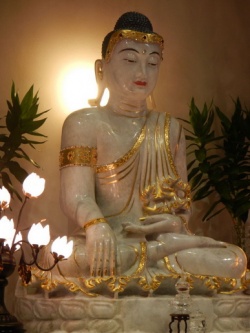Difference between revisions of "Flower Garland School (Huayanzong 華嚴宗)"
Jump to navigation
Jump to search
| Line 1: | Line 1: | ||
[[File:03 1280.JPG|thumb|250px|]] | [[File:03 1280.JPG|thumb|250px|]] | ||
| − | [[Fazang]] [[法藏]] (d. 712) founded the [[Garland School]] ([[Huayan]], Jap. [[Kegon]], Kor.: [[Hwaŏm]]) [[華嚴宗]], basing on the [[Garland Sutra]] [[華嚴經]]. The [[empty]] [[phenomena]] are [[thought]] to arose simultaneously by themselves. The static {{Wiki|principle}} ([[li]] [[理]]) and the dynamic [[phenomenon]] ([[shi]] [[事]]; things and their [[appearance]]) of the [[emptiness]] are interfused and mutually identified. No [[phenomenon]] can [[exist]] {{Wiki|independently}} and alone, all things depend on others and are combined to a whole. This system of {{Wiki|totality}} finally points to the [[Buddha]] in the center. | + | |
| + | |||
| + | |||
| + | |||
| + | |||
| + | |||
| + | |||
| + | |||
| + | [[Fazang]] [[法藏]] (d. 712) founded the [[Garland School]] ([[Huayan]], Jap. [[Kegon]], Kor.: [[Hwaŏm]]) [[華嚴宗]], basing on the [[Garland Sutra]] [[華嚴經]]. The [[empty]] [[phenomena]] are [[thought]] to arose simultaneously by themselves. The static {{Wiki|principle}} ([[li]] | ||
| + | |||
| + | |||
| + | [[理]]) and the dynamic [[phenomenon]] ([[shi]] [[事]]; things and their [[appearance]]) of the [[emptiness]] are interfused and mutually identified. No [[phenomenon]] can [[exist]] {{Wiki|independently}} and alone, all things depend on others and are combined to a whole. This system of {{Wiki|totality}} finally points to the [[Buddha]] in the center. | ||
| + | |||
| + | |||
{{R}} | {{R}} | ||
Latest revision as of 13:45, 26 December 2023
Fazang 法藏 (d. 712) founded the Garland School (Huayan, Jap. Kegon, Kor.: Hwaŏm) 華嚴宗, basing on the Garland Sutra 華嚴經. The empty phenomena are thought to arose simultaneously by themselves. The static principle (li
理) and the dynamic phenomenon (shi 事; things and their appearance) of the emptiness are interfused and mutually identified. No phenomenon can exist independently and alone, all things depend on others and are combined to a whole. This system of totality finally points to the Buddha in the center.
